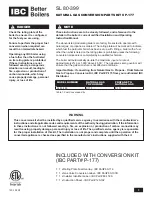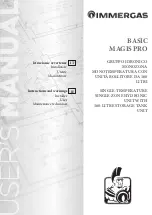
2
Page
1. Introduction
3
2. Boiler Specification
4
2.1 Technical Data
4
2.2 Dimensions
5
2.3 Boiler connections
5
2.4 Function diagram
6
3. General Requirements
7
3.1 Related documents
7
3.2 Boiler location
7
3.3 Gas supply
8
3.4 Flue system
8
3.5 Air supply
10
3.6 Electricity supply
10
3.7 Guide to system requirements 10
4. Boiler installation sequence
13
4.1 General
13
4.2 Boiler delivery
13
4.3 Preparation of boiler location 14
4.4 Installing the flue system
16
4.5 Mounting the boiler
16
4.6 Connecting the flue assembly
to the boiler
17
4.7 Electrical installation
19
4.8 Controls
20
5. Commissioning
22
5.1 Preliminary electrical checks 22
5.2 Gas supply
22
5.3 Water supply
22
5.4 Filling the heating system
23
5.5 Initial system flush ('cold')
23
5.6 Initial lighting
24
5.7 Gas inlet working pressure
25
5.8 Main burner pressure
25
5.9 Adjusting central heating
output (range rating)
26
5.10 Functional checks
27
5.11 Checking flame
supervision device
28
5.12 Final system flush ('hot')
28
5.13 Fitting case
28
5.14 Handing over to user
29
Page
6. Servicing
29
6.1 Initial inspection
29
6.2 Routine maintenance
30
6.3 Re-commissioning the boiler
31
7. Parts replacement
32
7.1 Initial preparation
32
7.2 Fan
34
7.3 Air pressure switch
34
7.4 Burner
35
7.5 Electrodes
35
7.6 Temperature sensor (NTC)
36
7.7 Gas valve
36
7.8 Main Heat exchanger
37
7.9 CH expansion vessel
38
7.10 Transformer
39
7.11 Overheat thermostat
39
7.12 Pump
39
7.13 Automatic air release
40
7.14 Automatic bypass
40
7.15 Diverter valve
40
7.16 Pressure and temperature
gauge
41
7.17 Differential pressure switch
41
7.18 DHW microswitch
42
7.19 DHW heat exchanger
42
7.20 Circuit boards
43
8. Fault finding
44
8.1 Introduction
44
8.2 Logical fault finding procedure 44
8.3 Fault finding charts
45
9. Electrical diagrams
54
9.1 Functional flow diagram
54
9.2 Wiring diagram
55
9.3 Schematic appliance
circuit diagram
56
10. Short parts list
57
11. Supplementary LPG
information
59
Leave these instructions with the user
when the installation is completed.



































